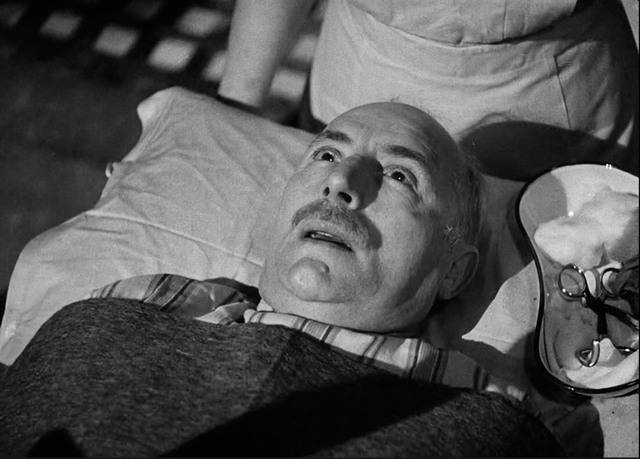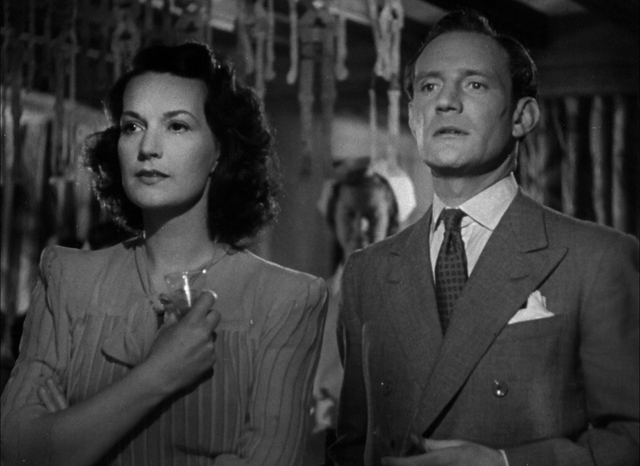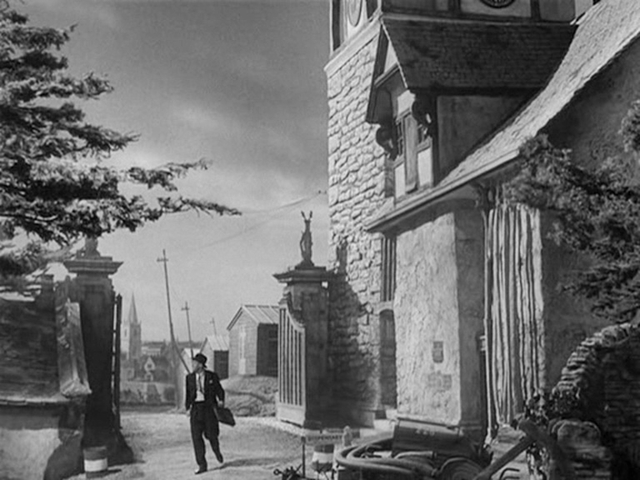There’s a scene midway through Green for Danger – a murder mystery by British writer/director Sidney Gilliat made in 1946 – where Inspector Cockrill from Scotland Yard is talking with a suspect in a pair of murders at a hospital in rural Kent. Cockrill, we already know, is a bit of an oddball with a rather elevated sense of himself, prone to blunt answers and a bemused and dismissive manner.
He’s interrogating Dr. Barnes (Trevor Howard), the anesthetist whose patient, the local postman, was the first victim, dying on the operating table. As played by Alastair Sim, Cockrill is a detective who has unseemly fun with his job, and while he presses Barnes on the particulars of the postman’s death he sits on a stool and tells Barnes “bear with me, doctor – I’m a child in these matters.” As if to accentuate this statement, he starts spinning around, hugging his briefcase and umbrella and smiling ruefully.
For anyone who knows Sim’s work outside of an annual viewing of his Scrooge in A Christmas Carol, you can imagine how perfectly he commands the scene, stealing it effortlessly from the normally estimable Howard. Green for Danger is often referred to as a British film noir, and the picture’s deep shadows and anxious, expressionist camera work fits the bill, but it’s hard to imagine Sim’s Cockrill as anything other than comic relief in a Hollywood noir, never mind inhabiting the role customarily filled across the pond by Dana Andrews, Alan Ladd, Dick Powell or Humphrey Bogart.
Once you get past the shared language, there are dozens of differences between Britain and America, and one of them is the ungrudging respect accorded the English eccentric – difficult but endearing, obsessive and unselfconscious; they pepper the secondary casts of period films and are utterly essential when telling a story set anywhere from a weekend at a country house to the terraced houses of the working class. But they can just as easily take centre stage and become heroic, as in Green for Danger (or A Canterbury Tale or The Scarlet Pimpernel or The Man in the White Suit or Lawrence of Arabia.) It’s one of those things – like Green for Danger – that makes British cinema feel like Hollywood in a parallel universe.
The film is set in 1944 during Doodlebug Summer, when Germany had begun their V-1 offensive, launching their “buzz bombs” against Britain daily. Their target was mostly London, and they had to fly over the Kentish countryside to get there, often dropping from the sky along the way; the very first V-1 attack against Britain actually fell short of the capital and hit the Thameside village of Swanscombe, less than a week after D-Day.
Several times during the film we hear the pulsejet of a V-1, which halts conversations and sends characters scurrying for cover when the engine stops and the 12-second countdown to the bomb’s impact begins. The distinctive flatulent rumble of the buzz bomb would have been instantly evocative to British cinema audiences in 1946, many of whom had just lived through the nearly ceaseless attacks from the V-1 and its successor, the supersonic V-2 rocket, which had only ceased near the end of March the previous year, just a few weeks before Germany surrendered.
One such buzz bomb attack sets the film in motion, its victim the unfortunate postman Higgins, who’s trapped in the wreckage of a civil defense bunker – a phenomenal scene that plays out to the sound of a female “Lord Haw Haw” broadcast on the radio, which is still playing in the dust and rubble (“This is Germany calling. This is German calling.”) He’s brought to Heron’s Park, an emergency hospital in an old Tudor manor house doubtless set up during the Blitz, now back in full swing with the latest round of terror bombings.

He goes under the gas in the operating theatre and never wakes up, which makes everyone in the room with him suspects, in the finest Agatha Christie tradition. There’s Howard’s Dr. Barnes, the surgeon Dr. Eden (Leo Genn), a lothario who once had a successful practice on Harley Street, officious Sister Bates (Judy Campbell), jolly Nurse Woods (Megs Jenkins), far less jolly Nurse Sanson (Rosamund John), a local girl whose mother died trapped in bomb wreckage, and pretty Nurse Linley (Sally Gray). The suspects are reduced slightly when Bates is found dead with a knife in her heart in the same operating theatre just a couple of days later, after announcing to everyone at a hospital dance that she knows who killed Higgins, and has proof.
If it weren’t for the murders, the film would anticipate Doctor in the House, the politely ribald 1954 hospital comedy hit starring Dirk Bogarde that would spawn six sequels and a TV series. The doctors and nurses have woven a tangled web of relationships: Nurse Linley is breaking up with Dr. Barnes and has attracted the attentions of Dr. Eden, which pushes jealous Sister Bates to the breaking point as the roguish Eden had broke it off with her months earlier. Overseeing it all – poorly – is Dr. White (Ronald Adam), the pompous new hospital head, fond of lectures to the staff on the power of positive thinking.
Everyone has a motive or a secret or both, and Sim’s Cockrill sets himself among them like a cat in a henhouse, toying with his suspects in a cavalier fashion that turns out to be a grave mistake.

Sidney Gilliat produced Green for Danger with his writing partner Frank Launder, though he co-wrote this particular script with Claud Gurney instead of Launder, who was working on Captain Boycott (1947), a historical drama about Irish nationalists that also featured Sim as a Catholic priest. Gilliat adapted the film from a bestselling novel by Christianna Brand that he picked up in Victoria Station while waiting for a train.
He was drawn to Brand’s story “not by the detective, Inspector Cockrill” he recalled years later, “who, though by no means as dull a plodder as Inspector French (hero of a series of mysteries by Freeman Wills Crofts), did not exhibit very much in the way of élan…” Nor was Gilliat thrilled by the hospital setting, except for the anesthetist’s ritual, though he was grateful in the end when Sim replaced Robert Morley in the cast, after which “Cockrill turned into the sprightly, conceited extrovert of the film, with a dash of mild sadism and a decided tendency to jump to the wrong conclusion…”
Gilliat and Launder began writing together with Twelve Good Men (1936), a crime drama made for Warner Bros. in the UK as a “quota quickie,” and went on to a productive partnership during the rest of the decade, one highlight of which was the script for Alfred Hitchcock’s The Lady Vanishes (1938), the film that caught Hollywood’s attention for the director. The pair became producers, co-writers and co-directors with the propaganda picture Millions Like Us (1943), and their Individual Pictures production company would join Ealing, Gainsborough, Two Cities and The Archers (Michael Powell and Emeric Pressburger) in the little renaissance of British cinema in the ’40s and early ’50s.
Gilliat was ambitious with his picture, taking over all of the soundstages at the then-new Pinewood Studios for Green for Danger, even going so far as to build a duplicate operating theatre set so that the actors and camera would only have to move a few yards to capture “reverse” angles. Working on his own for the first time, he had no idea how expensive this decision would be, but it produced a film with a startling and evocative look.

Except for two brief outdoor shots near the beginning of the picture, all the scenes – exteriors and interiors – were shot at Pinewood, including miniatures of the manor house and its hospital outbuildings. (Quite literally a Little Britain.) Along with the obviously painted backdrops in the background of shots and the fantastic sequence where Sister Bates runs from the manor house at night through the grounds to the operating theatre, pursued by some unknown assailant, they lend Green for Danger a mood out of some sinister fairytale.
It was also fortunate that Gilliat’s cast could stand up to Sim’s habitual scene-stealing; even Judy Campbell, who has the least screen time of all the main cast, is indelible as the tightly wound, half-mad Sister Bates, playing the role with a repressed erotic charge that recalls Kathleen Byron in Powell and Pressburger’s Black Narcissus (1947). Genn’s Dr. Eden is a fine portrayal of a sybaritic male, unwilling to imagine that his dalliances are at all painful for anyone else, imploring Campbell’s Bates to “be sensible.” Writers often describe his Eden as sporting an expression like “the cat who got the cream.”
Green for Danger opened to excellent reviews and good box office, but Gilliat’s extravagance during filming had an unfortunate impact on profits. In the late ’30s Sim had played Sgt. Bingham, the sidekick to Gordon Harker’s Inspector Hornleigh in a series of detective films. Christianna Brand wrote a series of novels featuring Inspector Cockrill, which could have formed the basis for many hoped-for Green for Danger sequels starring Sim as Cockrill – if only profits had been more appreciable. In any case political factors – a proposed tariff on American films by Clement Atlee’s Labour government and a subsequent production glut by J. Arthur Rank in response – made conditions for more Cockrill films even more unfavorable.

The closest Sim would get would be Poole in An Inspector Calls (1954), director Guy Hamilton’s adaptation of the J.B. Priestley play – a far more brooding character, in a much less amusing story. In any case Sim’s next decade would be his best, with pictures like Hue and Cry for Ealing, London Belongs to Me, Hitchcock’s Stage Fright, as the headmaster in The Happiest Days of Your Life, Laughter in Paradise, Lady Godiva Rides Again, The Belles of St. Trinian’s (playing both a spiv and his headmistress sister), The Green Man and Left, Right and Centre.
This is a great short list for anyone who wants to explore the marvel that was Alastair Sim, having only seen his Ebenezer Scrooge in the 1951 classic. It also happens to cut a fine cross-section through British film during a golden period – achieved despite official austerity in a post-war period often recalled as dreary. Going by the films, it was anything but, and time willing I’ll try to revisit Sim and this period here soon.
Mark Steyn Club members can let Rick know what they think by logging in and sharing in the comments below, as access to the comments section is one of many benefits that comes along with membership in the Mark Steyn Club.
© 2022 Mark Steyn Enterprises (US) Inc. All rights reserved.
No part of this website or any of its contents may be reproduced, copied, modified or adapted, without the prior written consent of Mark Steyn Enterprises.
If you’re a member of The Mark Steyn Club and you take issue with this article, then have at it in our comments section.
Source link
Author





